Minimalist greenery is all about intentional simplicity. It means decorating your home with artificial plants that are clean, understated, and harmoniously integrated into your space—without overwhelming it. Rather than filling every surface with foliage, minimalist greenery celebrates empty space, clean lines, and calm, curated accents.
Why is this concept so popular right now? In a world filled with visual noise and digital clutter, people crave serenity at home. Minimalist greenery delivers that. It combines the natural look of indoor plants with the ease and permanence of faux decor—no watering, no soil, and no stress.
Perfect for modern interiors, Japandi-inspired spaces, and neutral-toned rooms, minimalist greenery adds softness and structure without stealing attention. This guide will walk you through how to style it, where to use it, and which products elevate your space without complicating it.
Table of Contents
Key Characteristics of Minimalist Plant Styling
Minimalist greenery isn’t about adding plants everywhere—it’s about choosing the right ones and placing them with purpose. The hallmark of this style is restraint. It’s the careful balance between simplicity and beauty, where fewer elements make a bigger impact.
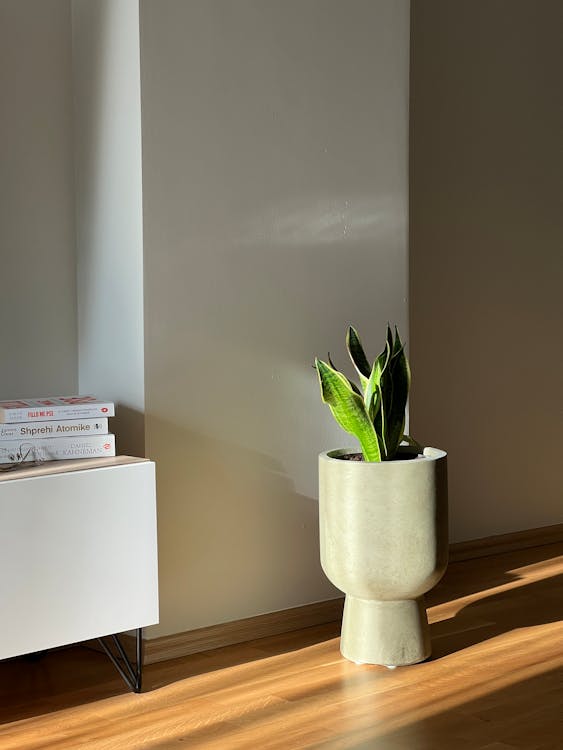
1. Clean Lines and Sculptural Shapes
Minimalist faux plants often feature sleek silhouettes. Think snake plants with tall upright leaves, or small succulents with defined edges. These shapes complement modern furniture and minimalist layouts without adding chaos. The form of the plant should echo the geometry of your space.
2. Neutral and Muted Tones
Instead of bright or saturated greens, minimalist greenery leans toward soft eucalyptus shades, dusty olives, or even variegated whites and grays. These tones blend effortlessly into interiors dominated by whites, blacks, wood, and stone.
3. Textural Contrast
In minimal design, texture adds interest where color and clutter do not. A single potted plant with velvety leaves or a pebbled concrete base adds visual depth without complicating your design. Faux plants that mimic natural fiber, silk, or matte ceramic planters work beautifully here.
4. Intentional Placement
Incorporating minimalist greenery means being strategic. Place plants where they soften harsh edges or add life to a bare surface. Common spots include coffee tables, bathroom shelves, and nightstands. A single well-placed plant in a clean white pot does more than five random arrangements.
5. Quality Over Quantity
This is the golden rule. In minimalism, one realistic artificial plant is more powerful than a room full of plastic-looking decor. Invest in higher-quality pieces that last, and space them out to give your layout breathing room.
Best Rooms to Use Minimalist Greenery
Minimalist greenery can subtly enhance every room in your home—if used with intention. Below are the most popular spaces where artificial plants add calm, texture, and quiet beauty without interrupting the minimalist flow.
1. Living Room
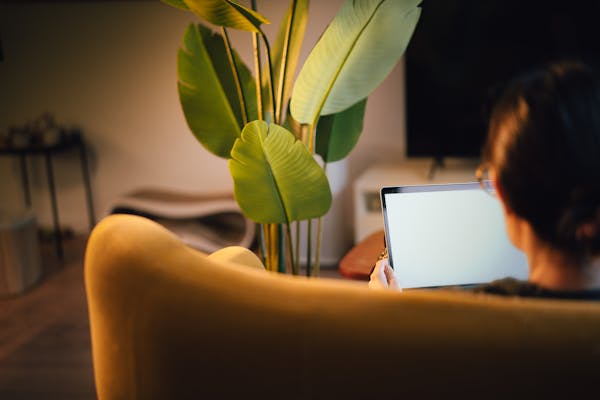
The living room is the heart of your home—and the best place to start with minimalist greenery. Opt for a single faux tree in the corner (like a pared-back fiddle leaf fig) or a tabletop succulent on your coffee table. Pair your greenery with soft throws, neutral rugs, or sculptural vases for balance.
A good rule of thumb: if your living room has bold architecture or oversized furniture, go for taller plants with clean shapes. If your furniture is low and minimal, choose compact, structured greenery.
2. Bathroom
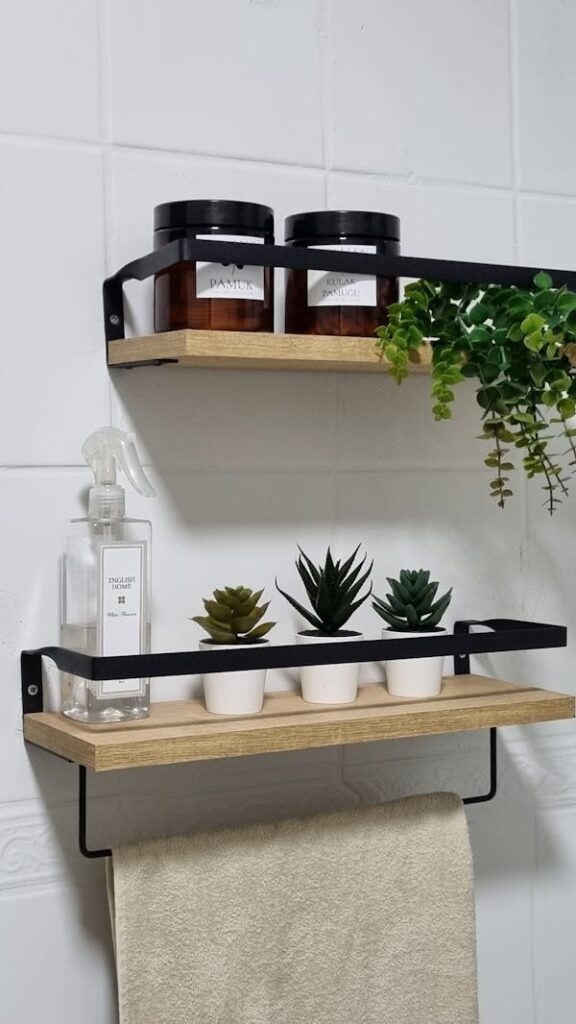
Bathrooms benefit immensely from small artificial plants. Humidity-proof and hassle-free, faux greenery can make your space feel like a spa. Place a mini eucalyptus arrangement on the vanity or a potted aloe vera on a shelf for that calming effect without worrying about water damage.
3. Home Office

Faux plants in your workspace can improve focus, reduce visual fatigue, and soften tech-heavy environments. Choose a single plant with a strong shape—like a snake plant or structured succulent—and place it where it can be seen but not distract from your screen.
Minimalist greenery in the office helps reduce clutter without losing the benefits of biophilic design.
4. Bedroom

Calm is key in the bedroom. A soft, dusty green artificial fern or a compact silk palm on a bedside table helps create a sleep-friendly vibe. Avoid anything too tall or dense—especially near your headboard. One or two small, low-maintenance pieces are enough to complete the look.
5. Entryway
Your home’s first impression matters. A single clean-lined faux plant beside a mirror or bench brings polish to your entryway without cluttering the space. Choose plants in natural ceramic or matte white planters to keep the look cohesive.

Minimalist Faux Plant Product Recommendations
Below are curated artificial plants that embody the essence of minimalist greenery—clean lines, calming tones, and compact design. Each pick fits seamlessly into neutral, clutter-free spaces while offering effortless style.
1. Scindapsus Aureus in Matte Pot
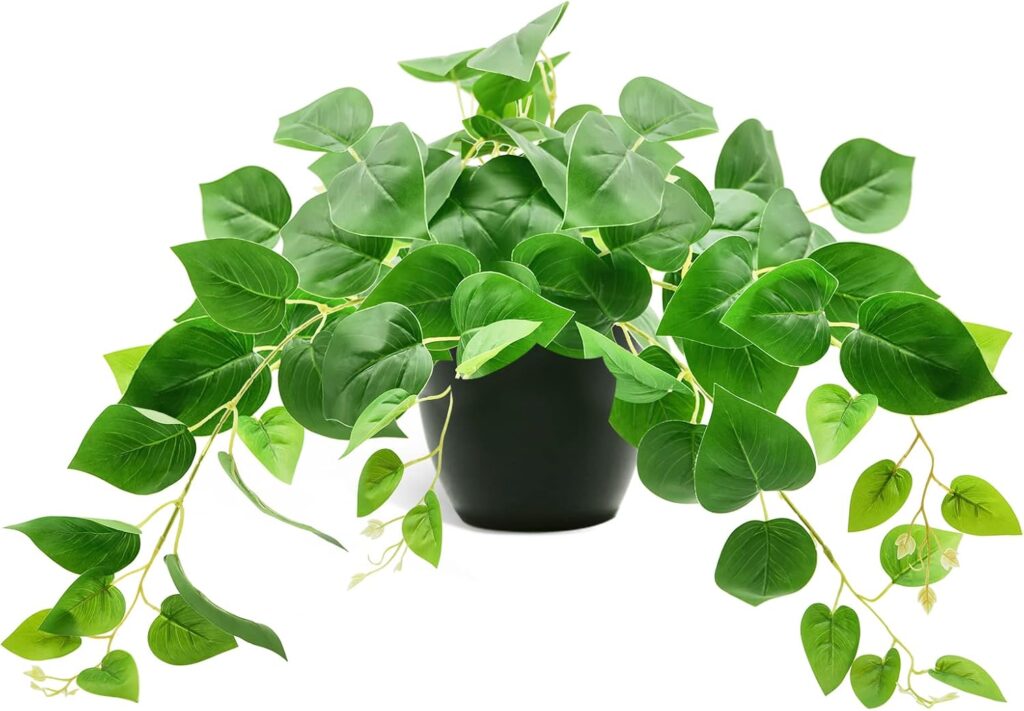
This realistic Scindapsus Aureus comes in a soft matte black pot and features trailing leaves with natural veining. Its size makes it perfect for shelves, coffee tables, or bathroom counters.
2. Faux Eucalyptus in Ceramic Vase

Amore Florals offers a calming eucalyptus arrangement in a clean white vase. The subtle green tones are ideal for Scandinavian or Japandi interiors where restraint and harmony are key.
3. Sleek Snake Plant with Sculptural Form
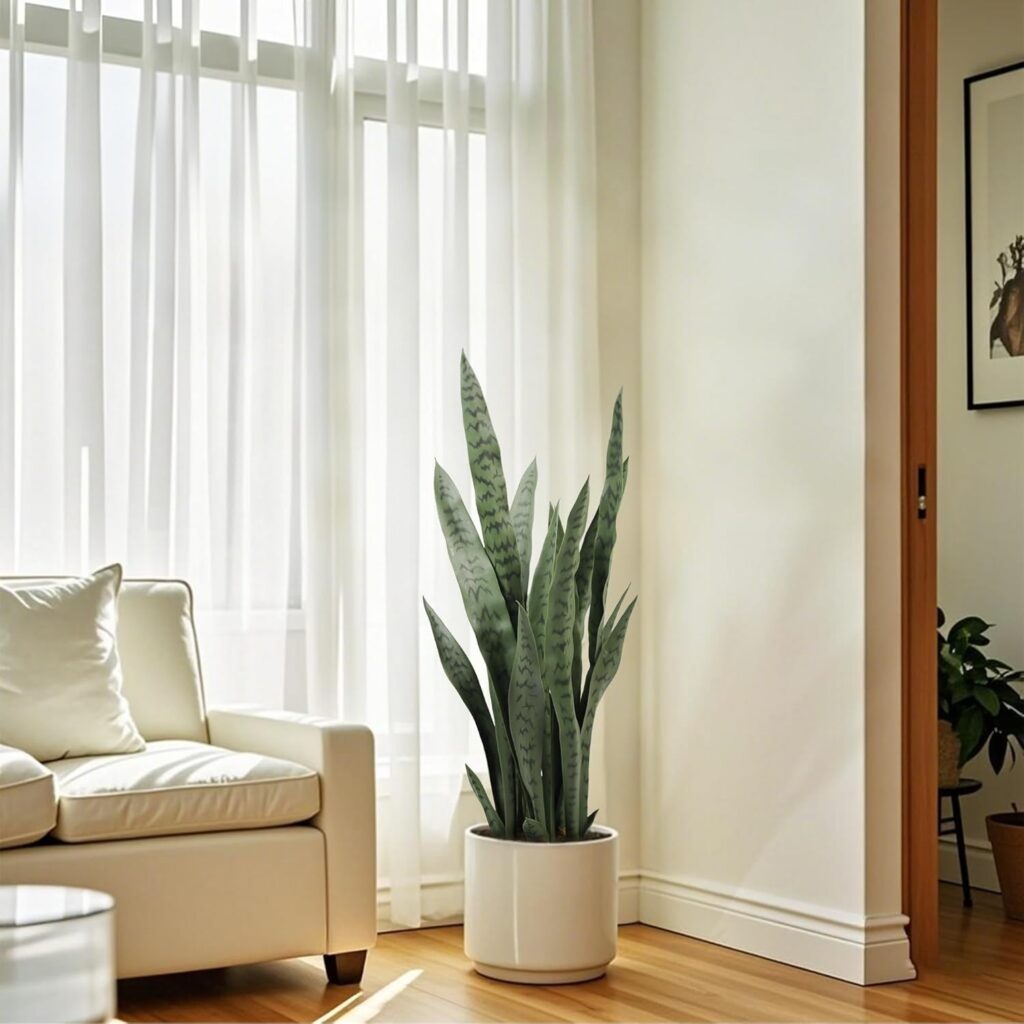
Prefer a bold vertical accent? This Faux Sansevieria mimics real snake plant leaves with precision. It’s great for corners, sideboards, or workspaces where structure and modernism reign.
4. Compact Succulent Trio in Muted Planters
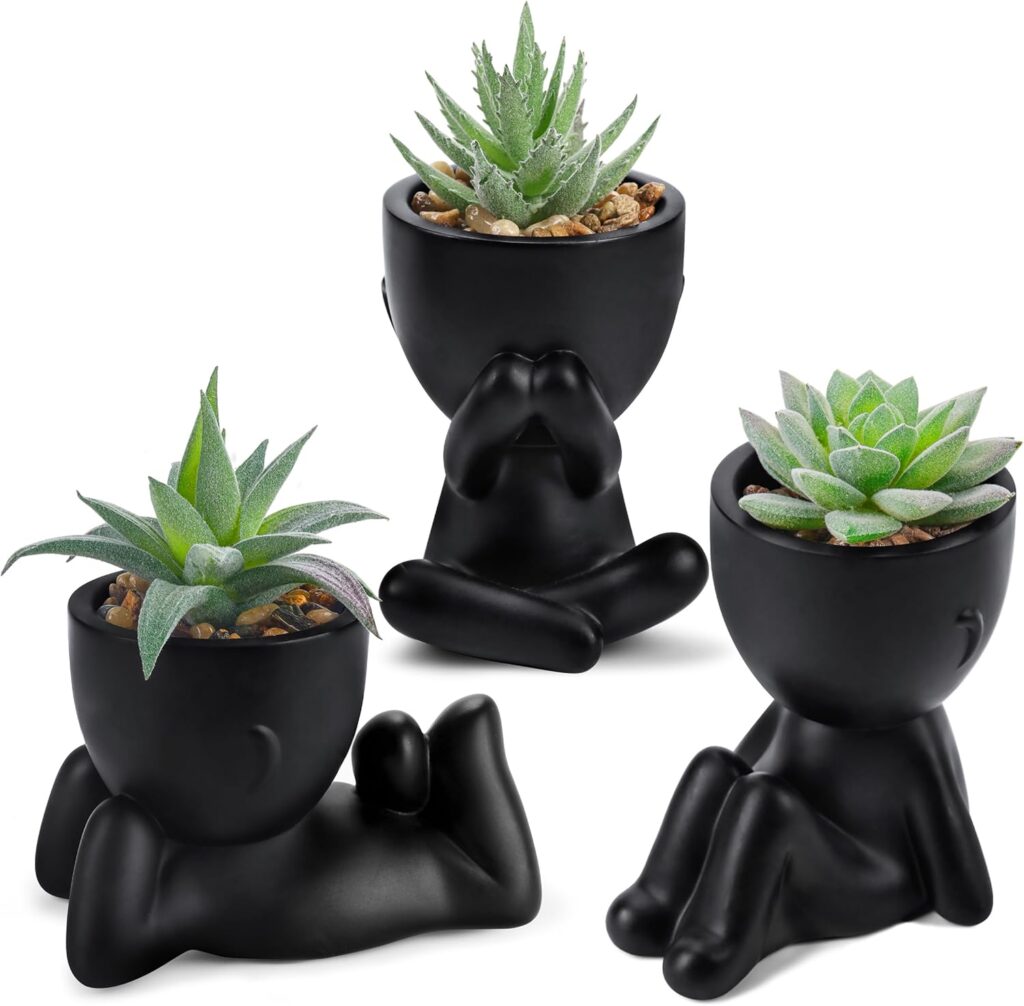
Minimalist doesn’t mean boring. This 3-piece succulent set includes varied textures and muted tones, perfect for bookshelves or work desks where you want understated style.
5. Mini Potted Ferns for Zen Corners

Add texture without bulk using this Eucalyptus and fern duo. The soft leaves blend beautifully into neutral palettes and bring a spa-like calmness to vanities or entry tables.
Styling & Placement Tips for Minimalist Greenery
Choosing the right minimalist faux plant is only half the equation—placement and styling bring the look to life. The goal is to complement your existing aesthetic without visual clutter. Here’s how to style minimalist greenery like a pro:
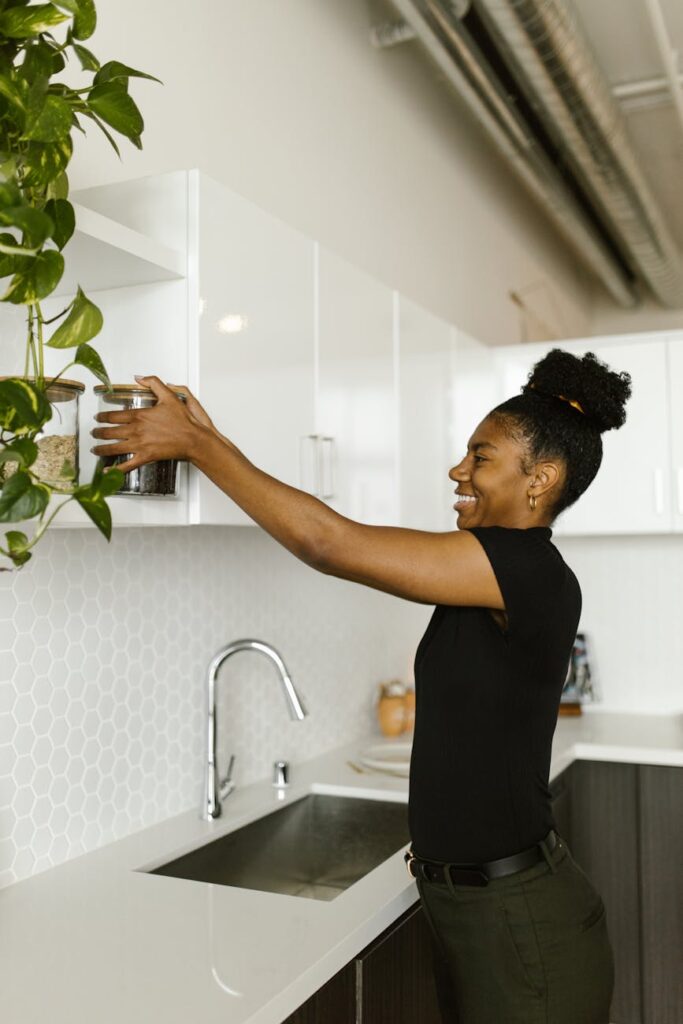
1. Use Negative Space
In minimalism, space is sacred. Let each plant breathe. Avoid placing faux greenery too close to other objects. Instead, allow the plant to stand alone on a shelf or table so it becomes a subtle statement piece.
2. Group in Odd Numbers
While minimalist design avoids excess, when grouping is needed, go with odd numbers—typically three. Combine a small faux plant, a candle, and a neutral object like a ceramic vase for balance and depth.
3. Stick to a Neutral Color Palette
Ensure the plant and planter fit within your room’s palette. For minimalist interiors, whites, beiges, blacks, and muted greens are ideal. Avoid neon or glossy finishes that break the visual harmony.
4. Choose Low, Clean Pots
Planters are part of the design story. Choose matte, stone-textured, or raw ceramic pots. The pot shouldn’t outshine the plant—it should feel like a natural extension of your room’s design.
5. Use Trays to Anchor Small Arrangements
A decorative tray helps contain and define grouped elements. Try layering a small faux fern, a diffuser, and a minimal sculpture within a tray on your coffee table or entry console.
6. Keep Surfaces Uncluttered
Don’t fill every empty space. Let some surfaces remain bare so the greenery can speak. Less really is more when designing with intention.
Frequently Asked Questions (FAQs)
What is minimalist greenery?
Minimalist greenery refers to the use of simple, carefully selected faux plants that enhance a space without adding visual clutter. It emphasizes clean lines, muted colors, and strategic placement for a calm, stylish aesthetic.
Are artificial plants suitable for minimalist homes?
Yes. High-quality artificial plants are perfect for minimalist homes because they offer lasting beauty without the maintenance. They blend seamlessly with modern, Japandi, and Scandinavian interiors when chosen thoughtfully.
Which faux plants look best in minimalist settings?
Snake plants, eucalyptus stems, succulents, and ferns are excellent choices. Look for sculptural shapes and neutral-toned pots that align with your room’s palette.
How do I keep artificial plants looking realistic?
Dust them regularly using a microfiber cloth. Occasionally rinse leaves with water or use canned air for detailed cleaning. Avoid over-accessorizing around them—let the plant shine on its own.
Can I use faux plants in bathrooms or kitchens?
Absolutely. Artificial greenery thrives in places where real plants may not—like bathrooms with low light or kitchens with changing humidity. Just avoid placing them near extreme heat or water sources.
Is artificial greenery safe for pets?
They are generally much safer than real plants. Many live plants are toxic to cats and dogs.
Artificial plants are a great worry-free alternative. For more tips, check DogFluffy.com.
Conclusion
Minimalist greenery proves that less truly is more. With the right faux plants and thoughtful placement, you can create a calming, modern space that feels intentional and elevated. Here’s a quick recap:
- Minimalist faux plants offer clean shapes, muted tones, and maintenance-free beauty.
- Quality matters—invest in realistic textures and timeless forms that blend with your decor.
- Use negative space, neutral palettes, and sculptural planters for best visual impact.
- Place plants in living rooms, bedrooms, bathrooms, and offices for balanced harmony.
- Choose artificial greenery that adds warmth and focus, not clutter.
Whether you’re refreshing a corner or restyling your entire home, minimalist greenery is a timeless design move. Explore our product recommendations and create your serene space—without the fuss.
Want to find out more? Make sure to check out more of our helpful blogs here.





Leave a Reply
You must be logged in to post a comment.